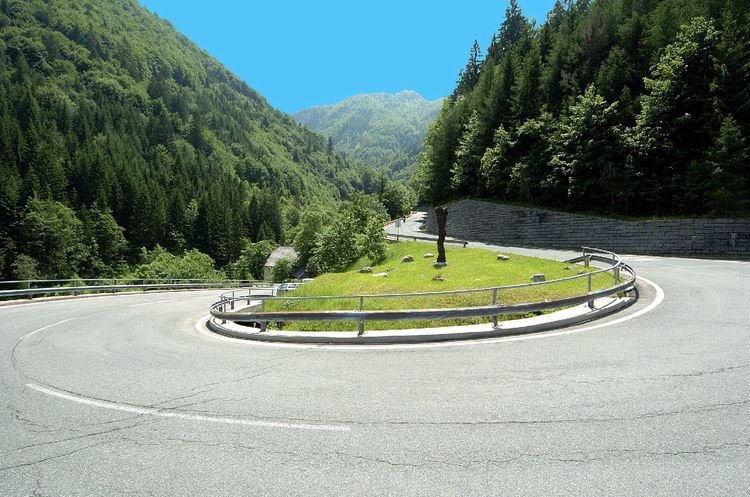Traversed by road Range Alps | Elevation 1,367 m | |
 | ||
Similar | ||
The Loibl Pass (German: Loiblpass) or Ljubelj Pass (Slovene: prelaz Ljubelj) is a high mountain pass in the Karawanks chain of the Southern Limestone Alps, linking Austria with Slovenia. The century-old pass near the Stol summit is the shortest connection between the Carinthian town of Ferlach and Tržič in Upper Carniola.
Contents
- Map of Loibl Pass 4290 TrC5BEiC48D Slovenia
- Early historyEdit
- Short first tunnelEdit
- Loibl TunnelEdit
- 1991 onwardsEdit
- References
Map of Loibl Pass, 4290 Tr%C5%BEi%C4%8D, Slovenia
Early historyEdit
Different trails were used since ancient times, connecting Virunum in the Roman province of Noricum with Emona (at present-day Ljubljana). The strategic importance of the Loibl increased again after the establishment of the Imperial March of Carniola in the 11th century, the ruling Patriarchs of Aquileia entrusted the maintenance to the monks of Viktring Abbey, who rivaled with claims raised by the local Lords of Hollenburg (Humberk) Castle.
Short first tunnelEdit
From about 1560 the estates of the Carinthian duchy had the road extended. A 150 m (500 ft) long tunnel was built underneath the Karawanks chine, an early example of modern engineering that later had to be abandoned due to lack of safety. Another attempt was planned in the 17th century, as the road across the Loibl had become an important trade route between the Carinthian capital of Klagenfurt and the seaport of Trieste. However, when in 1728 Emperor Charles VI toured the lands of the Habsburg Monarchy he still had to travel over the summit, stopping by the Deutscher Peter tavern and ordering some road work.
Loibl TunnelEdit
During World War II, a 1,570 m (5,150 ft) meter long tunnel was built at 1,068 m (3,504 ft) above sea level by the command of Nazi Gauleiter Friedrich Rainer. It was carried out by 660 civil workers, including several posted by the French Service du travail obligatoire, and 1,652 prisoners of two minor sub-camps of the Mauthausen-Gusen concentration camp. The camps, one on each side of the pass, were run by the notorious SS commandant Julius Ludolf. Tunnel construction started in 1943; to keep the work force effective, injured or sick prisoners were sent back to the main camp or else executed by camp physician Sigbert Ramsauer (de) by the injection of petrol if unable to be transported. On 7 May 1945, the remaining 950 inmates from the two camps were largely abandoned by guards and began marching to Feistritz im Rosental, where they met partisans on the following day. As the survivors had in effect 'freed themselves', theirs were the only sub-camps of Mauthausen-Gusen not to be either evacuated or liberated at the end of the war.
Today a memorial marks the site of the southern Loibl camp. An American military court sentenced Julius Ludolf to death on 13 May 1946. British military courts sentenced two other SS commanders of the camps, Jakob Winkler and Walter Briezke, to death on 10 November 1947, and sentenced Sigbert Ramsauer to life imprisonment 10 October 1947. Ransauer was released in 1954 however, and soon became a physician at Klagenfurt hospital.
The first army vehicles passed through the very tight tunnel on 4 December 1944. Military traffic, Wehrmacht soldiers retreating from the Yugoslav Front and refugees used the tunnel until it was closed in 1947. It was reopened as a border crossing between Austria and the Federal People's Republic of Yugoslavia in 1950 and expanded in the early 1960s to open for two lanes on 1 July 1964. The old road over the summit of the mountain pass has been closed for traffic since 1967.
1991 onwardsEdit
The importance of the Loibl Pass has diminished since 1991, when the 7,864 m (25,801 ft) long Karawanken Motorway Tunnel, which connects the Austrian Karawanken Autobahn (A 11) from Villach with the Slovenian A2 motorway to Ljubljana, was opened. Border controls were abolished when Slovenia joined the Schengen Area effective from 21 December 2007, but have been restored temporarily for entry to Austria in the wake of an increased number of illegal border crossings during the "migrant crisis" of 2015-2016.
